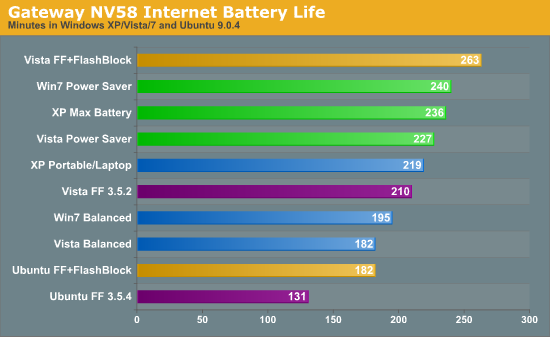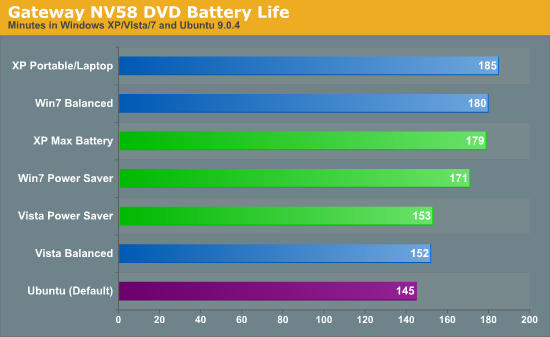Gateway NV58 (Intel) - Battery Life
We first looked at AMD's mobile platform with several operating systems and now it's Intel's turn. Once again, here's the rundown of specifications followed by the results, starting with battery life.
| Gateway NV5807u Test System | |
| Processor | Intel Core 2 Duo T6500 (Dual-core, 2.1GHz, 2MB shared L2, 45nm, 35W, 800MHz FSB) |
| Memory | 2x2048MB Micron PC2-5300 @ DDR2-667 5-5-5-15 (Micron Technologies 16HTF25664HY-667G1) |
| Graphics | Integrated Intel GMA 4500MHD Driver version 15.13.4.64.1829 10 Shaders at 475 MHz |
| Display | 15.6" Glossy WXGA (1366x768) LG LP156WH2-TLE1 |
| Hard Drive | HITACHI Travelstar 5K500.B 320GB 5400RPM 8MB (HTS545032B9A300) |
| Optical Drive | 8x DVDRW (TSST Corp TS-L633B) |
| Battery | 6-Cell 10.8V, 4400mAhr, 47.5Whr |
| Operating System | Windows Vista Home Premium 64-bit |
| Price | NV5814u available online starting at $580 |


If you expected the standings to remain the same regardless of computer hardware, you might be in for a bit of a surprise by the above charts. This time, Windows XP wins in both DVD playback results, providing better battery life using the "Portable" profile than the "Max Battery" profile. Windows 7 also performs slightly better on DVD playback using the Balanced profile, whereas we saw virtually no difference between the power profiles using the NV52.
Why is Balanced beating Power Saver this time? Intel's SpeedStep technology appears to be better than AMD's PowerNow!, though minor differences in drivers may also contribute to the standings. The theory is that letting your CPU run at 100% for a short time and then returning to minimum power draw as fast as possible results in the best battery life, which is why setting the maximum CPU state to 50% isn't always the best idea. Intel CPUs are supposed to switch between C-states faster than AMD CPUs, or so we've heard, and these results seem to support that idea. However, the Internet battery tests again all favor the power saving profiles by a large margin, so power saving profiles can have a positive impact, just not in DVD playback. Ubuntu brings up the rear in both battery life tests once again.
Internet battery life shows different standings on the three Windows operating systems compared to the NV52. Windows 7 is just 2% ahead of XP and 6% ahead of Vista with the power saving profile; switch to the balanced profile and XP jumps into the lead offering 12% more battery life than Windows 7 and 20% more battery life than Vista. Looking at the profiles, Windows XP shows the smallest change by using a power saving profile, improving by 8% when using the Max Battery option. Windows 7 and Vista both improve by around 25% (23% for Windows 7). That means all three Windows OSes did better in Internet battery life with power saving profiles relative to the NV52.
Our testing with Ubuntu once again requires a bit of explanation. First, LCD brightness adjustment did not work properly under Ubuntu (with the drivers we used), with the final setting ending up at 150 nits instead of 100 nits. That means battery life is going to be slightly lower because the LCD is consuming an extra 1-2W. Second, unlike the NV52, we didn't experience any difficulties with DVD playback - hooray! Internet performance using Firefox still feels horribly slow in comparison to Firefox or Internet Explorer on Windows, and while blocking Flash content helps we still prefer Windows.
Enabling FlashBlock with Firefox again has a substantial impact on battery life; Vista improves by 25% - the same as on the NV52 - and Ubuntu improves by 39% - slightly less of an improvement compared to the NV52. The gap between Vista and Ubuntu is still huge, even bigger than on the NV52. Without FlashBlock, Firefox on Vista offers 60% more battery life than Firefox on Ubuntu. Even with FlashBlock, the gap remains at 45%, which is far more than the Power Saver profile offers.
Overall, Windows XP leads in best-case battery life for DVD playback on the Intel platform, providing 3% more battery life than Windows 7 - not a huge difference. The gap between Windows 7 and Vista is much larger, with the best-case Windows 7 result being 18% higher than the Windows Vista scores. Ubuntu almost matches Windows Vista, and it might even match Vista if we could modify the LCD brightness.










106 Comments
View All Comments
aahjnnot - Tuesday, September 22, 2009 - link
I can't see what software was installed on the laptops. Real-world system performance is affected adversely by the installation of everyday software, and it seems highly probable that this would also affect battery life, startup times and suspend / resume / hibernate performance.It would be very interesting to see a real-world test to understand whether different operating systems are more or less affected by the cruft of daily computing. I'd suggest including anti-virus, an internet security suite, an office suite, Skype, Windows Messenger, a couple of games, itunes or equivalent, some printer drivers, some backup software and a camera management application.
JarredWalton - Tuesday, September 22, 2009 - link
The installs were all "vanilla", though I updated DirectX and installed the tested Futuremark suites on the Windows setups. In all cases, there were no Firewalls or AV software enabled. I disable automatic updates, firewall, Defender, indexing, screen savers, and set a static swap file size of 4GB. I do not try to disable any extra services, but I try to avoid any extra apps loading at start up (i.e. system tray icons that serve no real use).For Ubuntu, I just did the basic install and then tried to make it work. Easier said than done for a few areas. LOL. I manually added package repositories for Firefox 3.5, some drivers, and the necessary things to get DVD playback working. Far from a trim and speedy install, I know, but it's what Ubuntu uses by default, which means it's what most Ubuntu users will use.
aahjnnot - Tuesday, September 22, 2009 - link
I can understand why you chose a vanilla installation, but it means that your results are hardly representative of the real world. All Windows laptop users will need anti-virus; most will have a raft of additional software; and few will disable system tray entries.I run both XP and Ubuntu 9.04 on my laptop and on a couple of boxes at home. In all cases Ubuntu starts up significantly faster than Windows, and that's because cruft seems to affect Windows more than it does Linux - on my machines, a vanilla Windows installation is fast but unusable as it's insecure and has no applications.
stmok - Tuesday, September 22, 2009 - link
Which guide did you follow?JarredWalton - Tuesday, September 22, 2009 - link
This was the guide I found for the ATI platform:https://help.ubuntu.com/community/BinaryDriverHowt...">https://help.ubuntu.com/community/BinaryDriverHowt...
If their own BinaryDriver guide doesn't work, I don't have much hope for other alternatives!
stmok - Wednesday, September 23, 2009 - link
Hmmm...I see. Looking through the link you've provided leads to...Fix Ubuntu 9.04 ATI Driver Issue
http://tan-com.com/posts/technology/fix-ubuntu-904...
(This isn't a fix...Its merely being accommodating to the closed driver's deficiencies.)
Essentially, you want to stay away from ATI hardware until the open source community completes their work on the open driver for ATI solutions. ie: Waiting for xf86-video-ati driver to support your video solution. (Which will take quite a while! They're making slow progress.)
Generally, I research/pick my hardware BEFORE I install Linux. Sticking to Intel and Nvidia based solutions work best. Although, certain Intel IGPs like the GMA 500 is poorly supported. (Intel only provided a closed source driver for that particular solution).
Of course, one also has to understand that Linux is undergoing a major graphics stack re-write. (They are replacing three old components with one)...The initiative is being led by a few Intel employees and Xorg developers. This will affect recent Intel IGPs like the GMA 3xxx, GMA X3xxx and X4xxx series.
So I guess something like the Intel GMA900/950 IGPs or Nvidia supported solution are the ones to go for.
gstrickler - Tuesday, September 22, 2009 - link
Here are the conclusions I draw from this article:1. Anand/AnandTech will admit when their testing procedures are inadequate. Always a sign of a good researcher. Thanks, looking forward to updates when you find a more repeatable set of for "internet battery life"
2. Win 7 drivers may still need tuning for performance and/or battery life.
3. Win 7 battery life improvements are not likely to be the 30%+ that some vendors are claiming. You might get that much best case, but typical results will be much lower.
4. Vista sucks. Use XP or Win 7 instead.
5. Flash sucks. Ok, Flash is actually cool and useful, but it's implementation sucks. Adobe has never been known for small, fast, or efficient code.
6. Currently, Intel beats AMD in power usage/battery life.
We already knew #4-#6, and suspected #1-#3. The good news is this confirms what we already knew or suspected. The bad news it that it doesn't give us much new information.
andrewaggb - Tuesday, September 22, 2009 - link
Well I found a couple things interesting, power profiles matter but not necessarily as much as you'd think.And it had never occurred to me that disabling flash would give way better battery life. It makes total sense, but without the article I wouldn't have thought of it.
Otherwise, I agree with your analysis of 1-6
I think the actual numbers are pretty questionable, but the author admits that there is a wide variance.
Otherwise I found the linux results amusing, as well as the comments. We can only hope that people who work for canonical actually read these reviews and work to improve the usability of their products.
maveric7911 - Tuesday, September 22, 2009 - link
Of All linux distributions to use, ubuntu has so much bloat its no wonder its eating battery like that. Please use other distributions out there rather then giving the same old ubuntu bloatware benches.MonkeyPaw - Tuesday, September 22, 2009 - link
"The minimum processor state is set to 5% and the maximum processor state is 100%; we don't know how this specifically affects CPU clock speeds"It's actually pretty simple, and the feature only works with CPUs that have Powernow or Speedstep. The "Maximum Processor state" is how fast the CPU is allowed to run when the system experiences high-cpu load (which would normally increase CPU speed). For example, if you have the maximum set to 50% and you have a CPU that runs at 2.0ghz, Windows will limit the clock speed scaling to what ever multi gets it closest to 1.0ghz. I have my Toshiba notebook limit my 2.1ghz Turion X2 to 50% (1.0ghz) while unplugged to conserve battery power. Note that these percentages are not an exact science, as it's all dependent on the predefined power states (available multi's) of the CPU you're using. It is, however, a way to improve battery life if you don't mind slowing the system down a little. Personally, I don't need that much power while unplugged, but in the rare occasions that I did, I could always change power plans from the battery icon in the taskbar.